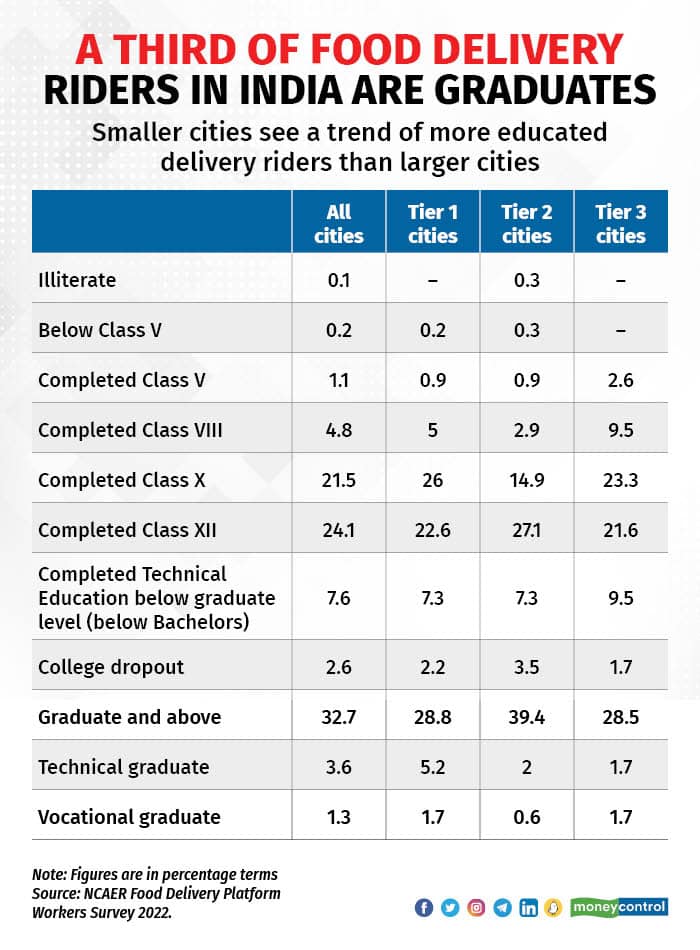



The real wages of gig workers delivering food parcels across cities have dropped significantly while volume of orders have risen and foodtech platforms have improved their unit economics over the past few years, according to a study by the National Council of Applied Economic Research (NCAER).
The survey of 924 food delivery workers found that their real wages decreased 11 percent to Rs 11,963 per month in 2022 from levels in 2019 because of rising fuel costs and consumer price inflation.
Real income refers to earnings after adjusting for inflation. It is also known as real wage. Nominal income represents earnings that are not adjusted for subsequent changes in inflation rates.
To be sure, the nominal income of the surveyed food delivery workers grew 4 percent to Rs 20,026 in 2022 from Rs 19,239 per month in 2019, according to the report.
“We found there was a mix of workers who saw their gross incomes rise and those who didn’t between their previous jobs and food delivery. However, their net incomes definitely decreased because of the high input cost of fuel and rising inflation,” said Bornali Bhandari, a professor at NCAER and lead researcher of the study.

Skills mismatch
One finding of concern was that gig workers were more academically qualified than their delivery work needed them to be. Importantly, a higher share of those with more educational qualifications was employed as delivery workers in the smaller cities.
The study found that more than a third of the food delivery workers had a graduate degree, a number that rose to 39.7 percent in tier-2 cities. A significant share (12.5 percent) had a technical and vocational degree or diploma.
According to industry estimates, there are 700,000 to 1 million food delivery workers on platforms like Zomato and Swiggy in India. The numbers vary with seasonality of demand.
“They are very highly educated... We found that before getting into food delivery, the workers had all kinds of jobs. There were cash accountants, drivers, artisans, businessmen, cashiers, cooks, all kinds. One person had even been the head of a polytechnic institute," said Bhandari.
The platform workers earned less in nominal terms (Rs 20,744 per month) than their peer group (Rs 22,494 per month) covered in the Periodic Labour Force Survey (PLFS) 2021-22. The peer group comprises workers in the 18-35 age group with at least higher secondary education. They were working 23 percent more than their peers and earning 8 percent less than them.

Changing incentives
There are two modes in which gig workers serve delivery platforms — as long-shift workers averaging 11 hours through the day or short-shift workers who do an average of five hours.
The numbers in the study show that long-shift workers get a base pay of Rs 42 per hour, whereas short-shift workers are remunerated higher at Rs 54 per hour.
However, the study noted that only long-shift workers qualify for daily and weekly targets set by platforms. If these targets are achieved, the worker gets incentives in addition to daily earnings.
The targets kept changing over time and cities. Targets were fixed in terms of amounts earned from delivering orders and not number of orders.
In north Goa, one worker reported that if they earned Rs 250 a day by delivering orders, they would get Rs 50 as incentive; if they earned Rs 300 on deliveries, they would earn Rs 80 as incentive; and if they earned Rs 500, they would earn Rs 120 as incentive. One inactive worker said if they earned Rs 350 in a day they would get Rs 80 as incentive.
“We found that workers who stay on with a platform for longer tenures see their productivity rise, which leads to higher incomes later on,” said Bhandari, adding that only 3 percent of delivery personnel worked simultaneously for two or more platforms.

Discover the latest Business News, Sensex, and Nifty updates. Obtain Personal Finance insights, tax queries, and expert opinions on Moneycontrol or download the Moneycontrol App to stay updated!